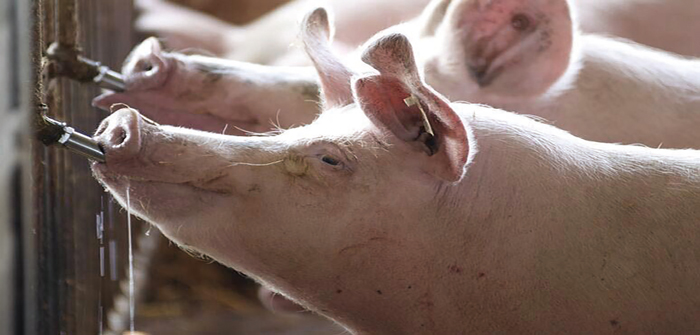Nigel Penlington and Emma Slater, from AHDB’s buildings and environment team, highlight some key points all producers should consider when it comes to ensuring good quality clean water for pigs
When it comes to pig water supply, both quality and quantity are equally important to get right. There are big opportunities to achieve better pig health and growth through simple changes to water systems, with untapped potential on many units. Pigs need ready access to good quality, clean, palatable water and their water intake is directly related to feed intake. However, when performance problems are investigated, the water supply is often overlooked.
There is another reason to check that the water system is optimised. In future, it’s likely medication will, more frequently, be delivered via water systems, as the industry continues with its efforts to reduce the use of antibiotics and become even more targeted with their use.
To help producers get up to speed, AHDB has just published a guide to help producers assess water system design and deliver the right quality and quantity of water to every pig. It includes key points all producers should consider, from system design to cleaning processes.
SYSTEM DESIGN AND FLOW RATES
The first step when designing or assessing a water supply system is to break down the unit into ‘command areas’, which may comprise one or more buildings, or differently stocked areas within a building. Nigel Penlington, AHDB head of environment and buildings (pictured), said: “Groups of buildings of similar age and design or that are used for a common purpose, such as farrowing or finishing, might form a command area as water demands are likely to be uniform across the group.
“Then, to minimise pressure differences between drinking points, the pipelines in command areas should be divided into header mains and laterals. Bear in mind that different diameter pipes may be needed for each.”
When it comes to drinkers, it’s important to make sure the right number and type are installed for particular groups of pigs. For example, the Defra Code of Recommendations for the Welfare of Livestock: Pigs (Defra, 2003) recommends that when ad lib feeding, one nipple drinker should provide an adequate supply for 15 pigs. When pigs are on rationed feed, a drinking point should be available for every 10 pigs.
“Treat these as a minimum requirement. It is a good idea to provide more than one drinker per pen to act as a back-up if a drinker becomes blocked or broken and carry out a daily check to make sure all drinkers are clean and working,” Mr Penlington said.
“To ensure an adequate flow rate through every nipple, bite drinker and float valve, take into account pressure loss due to friction in pipes. The lowest pressure at which many types of nipple drinkers will work is 0.2 bar. You can use gravity to supply a building if you use a header tank not less than 2.5m above the drinkers and select the correct drinker, pipe diameter and drinker regulator insert or setting.”
Where it is not practical to gain sufficient head from a header tank alone, you might fit a small booster pump to ensure good supply to all outlets.
“You also need to make sure the flow rate is adequate both mid-batch and between batches,” he said. “This is a simple task requiring a large measuring jug, a watch and a minute of your time. Check for any difference between those nearest to and furthest from the supply – the variation between drinkers may surprise you. A significant difference between the first and last drinkers could mean there’s a blockage or problem with the water pressure.”
Mr Penligton added a reminder about water storage to help ensure constant supply: “The volume of on-site storage should provide a buffer for use if there is any disruption in water supply. Producers need to consider the risks to pig welfare and the availability of alternative water supplies.”
WATER SAMPLING
Water sampling often shows that, while water may be quite clean as it enters the farm, the bacteria count rises by the time it reaches the drinker. Bio-film is a very common problem, restricting flow and causing blockages, especially where organic acids are used.
Emma Slater, AHDB environment and buildings KT manager (pictured), said: “The complete water line, including drinkers, pipework and header tanks, should be regularly cleaned and flushed through, between batches, for example. Alternatively, producers could use a continuous method using special chemicals, to help reduce build-up of biofilm and minimise coliform levels. Also check flow rates after flushing through, as dislodged film can cause blockages.
“We really encourage getting water samples analysed at a laboratory to check quality and/ or help investigate issues such as poor water intake or blocked pipes. Producers should speak to their vet or adviser first.” AHDB’s standard operating procedures provide a step-by- step guide to water sampling or microbiology (which is a farm assurance requirement) along with minerals, flow rate and water temperature.
She added: “It’s important to always use a sterile sampling bottle and ensure the seal has not been broken before use. Often, the laboratory testing the water is able to provide producers with bottles.
“It’s good to use a water system layout plan of the site being sampled to select and mark where samples are taken from, for example, entry onto the farm or at the drinker. It is recommended you take three samples at each point as it is really easy for a single sample to get contaminated and give misleading results.”
CHOOSE THE RIGHT ACID
If producers are using organic acids in water, the amount
of acid needed to achieve the desirable pH varies depending on the mineral content of the incoming water and therefore its buffering capacity.
“Regionally, water varies; not just hard and soft but also mains and borehole,” said Ms Slater. “It’s looking like chemical analysis of water should be the first step before choosing an acid, or blend of acids, and we’re working on further guidance on this.”
PROTECT PUBLIC SUPPLY
All farm premises must comply with the Water Supply (Water Fittings) Regulations 1999. This legislation includes
a requirement that water supplies to livestock accommodation and yard areas are to be protected by a suitable air gap to prevent the backflow of potentially contaminated or medicated water into the incoming public mains water supply.
MORE INFORMATION
For the new AHDB guide to water system design
plus water sampling photos and standard operating procedures, visit: https://pork.ahdb.org.uk/environment-buildings/water-soil-and-air/water-quality-and-quantity/.
Also, look out for workshops on this topic running in the autumn. Producers interested in working with AHDB to try out and demonstrate different aspects of water management should get in touch with Nigel Penlington or Emma Slater: pork.ahdb.org.uk/meet-the-team/






